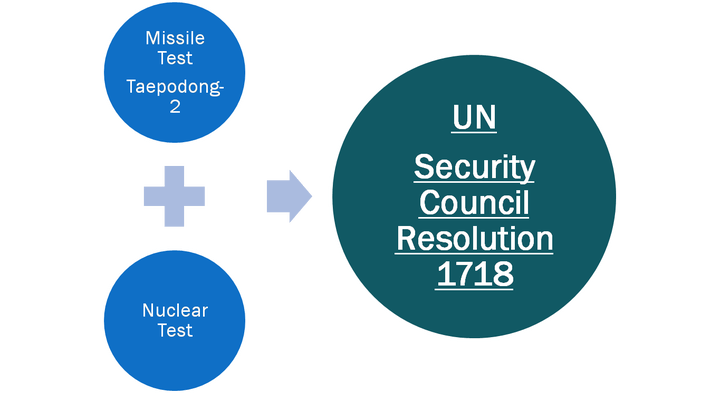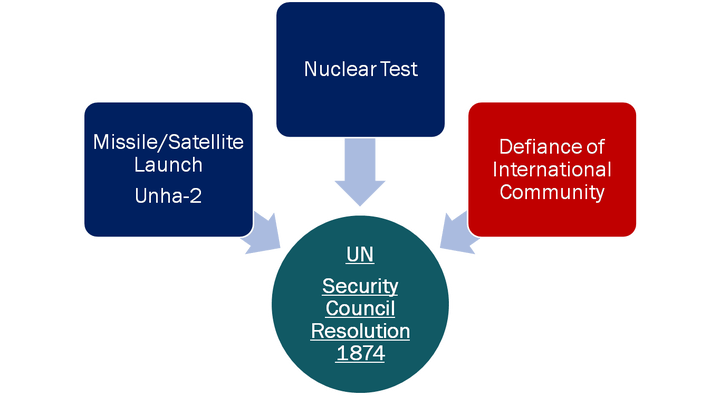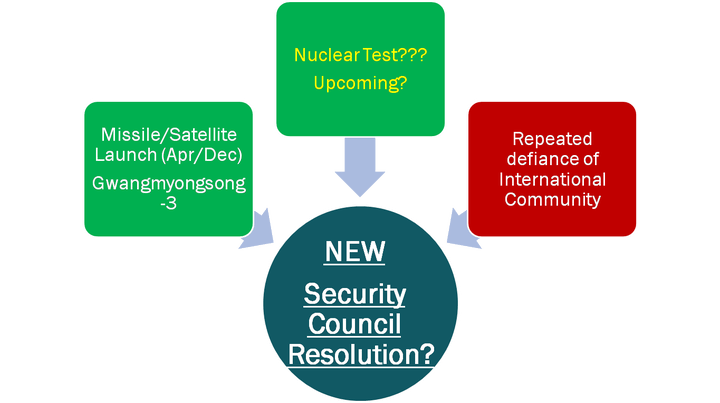Many experts were caught off guard by the surprise launch of the North Korean satellite on the 12 December. Many argued that another attempt to launch the rocket, after the failure in April, would not be until 2013. Even the South Korean government was steadfast in its belief that no launch would take place, choosing to release images of what they believed to be the dismantling of the rocket and the cancelling of the launch. Not only did the launch occur but after several failed attempts it was successful. The launch received typical international condemnation but if history is anything to go by then it follows a similar pattern to previous North Korean provocations. Therefore in 2013 can we expect to see a similar policy in defiance of the international community by the Kim Jong Un regime or can we hope for brighter relations?
Example 1:
2006: Taepodong-2

In July 2006 North Korea launched 7 rockets including one long range missile. These missile tests were not new. In 1993 a missile test was launched, largely in a trade with Iran for precious oil. In 1998 as relations deteriorated on the Korean peninsula, the DPRK launched another missile test. This time it came back to the discussion table in exchange for vital aid. In 2006 deteriorating ties once again led the DPRK to leave the six party talks discussions and participate in provocative behaviour. Later the same year nuclear tests were held further exacerbating the situation. North Korea blamed "the Bush administration's vicious hostile actions", signalling the decline of the relative peace that had existed earlier under the 'Sunshine Policy'.
As a result of the two actions the UN managed to slap down a resolution that imposed tough sanctions on the DPRK and demanded the end to missile testing. Largely it consisted of bans on any sort of transactions that had links to military hardware or missile related items. The sanctions also called for each UN member to investigate North Korean cargo if it had any suspicions it could be transferring prohibited items. Unfortunately these actions were not fully enforced by every nation and the united front against the DPRK crumbled. The credibility of the UN to deter the North's provocative acts was compromised. Eventually by February 2007 an agreement was reached. In exchange for emergency assistance the North would suspend all nuclear activity and allow IAEA inspectors back into the country to monitor its nuclear program.
Example 2:
2009: Gwangmyeongseong-2

Claiming the 'Outer Space Treaty' the DPRK attempted to send another satellite into space. However the international community did not see this treaty as enough justification and cited that contravening of the UNSC 1718 resolution. Later in 2009 another nuclear test occurred. A striking pattern was emerging. After initial condemnation by the international community for the missile test then another nuclear test, the UN was forced into applying further sanctions under the new UNSC Resolution 1874. It extended the arms embargo already in place and applied further economic and commercial sanctions. The pattern of missile test + nuclear test = sanction could be reappearing after the most recent launch in December.
In the past few years the DPRK has remained isolated. The international community has failed to shape the DPRK policy and prevent the nation from seeking confrontational acts in order to secure greater aid or more attention on the world scene. The bombing of the Cheonan ROK ship and the shelling of the South Korean island of Yeonpyeong were further incidents that went largely unpunished. The collective failure to prevent these acts and coax the DPRK government away from these choices is in part due to the fact they are aware that they can get away with it. As long as the acts are rewarded via aid or more say on the discussion table then the benefits outweigh the risks. In April 2012 another missile was launched but only enjoyed 90 seconds of success. The international community was once again up in arms but failed to show any meaningful deterrent or attempts at constructive dialogue. December marked the successful launch of the Gwangmyongsong-3 satellite as the UN stood by bewildered clutching the resolutions that the North continues to disregard. With this in mind what can we expect from 2013? Judging by history we can speculate that another nuclear test is due and the possibility of more sanctions or frantic discussion that rewards the North's aggressive behaviour.

Continual defiance of international rules and sanctions are unlikely to stop. Already in May 2012 the DPRK announced the reactivation of its nuclear program. For the DPRK they may see no other choice and ignoring their explanations of their acts is another failure on behalf of the international community. Via the KCNA the nation defended its policies; "Had any other country found itself in the situation of the DPRK, it would have clearly realized that the DPRK has never chosen but was compelled to go nuclear in the face of the U.S. hostile policy and its nuclear threats. It has become an absolutely impossible option for the DPRK to even think about giving up its nuclear weapons". The nation is already one of the most heavily sanctioned countries on earth and is seemingly backed into a corner. The international community worries over 'horizontal proliferation' (the selling of weapons or weapons technology to third parties such as Iran or non-state actors) however cutting off legitimate avenues of income and chastising the behaviour of the nation is not likely to be beneficial in the attempts to alter North Korean behaviour. A more constructive approach might be favoured as another set of sanctions are unlikely to garnish any sort of positive result, just further push the DPRK into the political wilderness. If the International Community sincerely wants to avoid the repeated pattern of provocation then a new tactic must be sought.
Some experts would contend that a new nuclear test is unlikely and some argue that realistically North Korea is very unlikely to have the capacity to actually build a functioning nuclear weapon. Regardless of its capabilities the acts remain aggressive and damage regional stability. The prediction may not be all doom and gloom though. There could be more positive signs in 2013 that many are failing to spot. New economic zones have sprouted up in North Korea and are encouraging Chinese firms to enter and pump money into the DPRK economy. While Chinese projects have not always been a success (Xiyang Group - a Chinese mining conglomerate accused the nation of stealing technology and sabotaging a deal in place creating bad blood between the participants) they could herald a brighter future. If they are sincere attempts by the North Korean regime then they might be imitations to previous Chinese successes, like the city of Shenzhen. Positive economic reform is in the best interest of the world community and acts like this should be supported and fostered. Also Kim Jong Un maybe sending rather indirect messages to the West in an effort for more dialogue. The released images of him enjoying famous Western animated characters may seem like a farfetched ploy to gain the attention of top leaders but it is not without precedent. Signals like these should not be ignored and in order to repeat a cycle of provocation the U.S. and the international community should constructively think of a new approach to North Korea. New leaders in China & South Korea and a returning leader in Japan should herald a new policy, a policy less retaliatory than years previous.